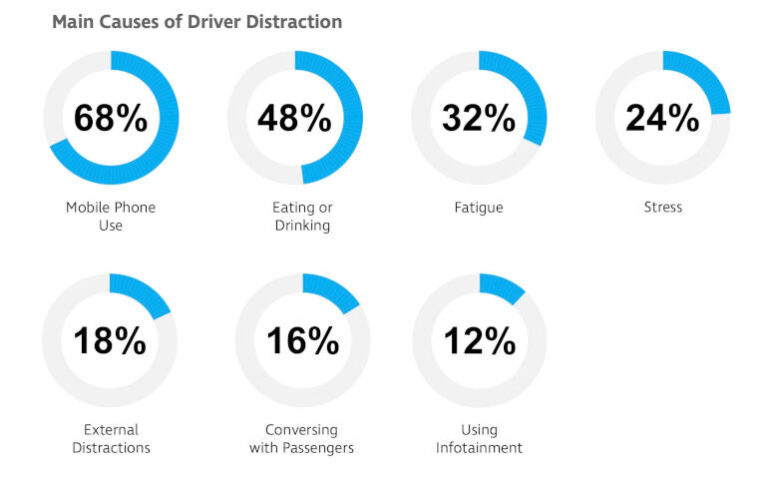Distracted driving remains a critical concern for businesses worldwide, with 70% of surveyed organisations reporting incidents that significantly impact safety, operational efficiency, and financial performance. Teletrac Navman’s 2025 Global Distracted Driving Report highlights the extent of this issue, its underlying causes, and how fleet operators can combat it effectively.
The Growing Issue of Distracted Driving
The primary driver distraction identified in the report is mobile phone use, cited by 68% of respondents. This reliance on devices poses safety risks and creates cascading challenges, including:
- Operational Disruptions: Productivity suffers when vehicles and drivers are sidelined by preventable incidents.
- Cost Increases: 61% of organisations reported direct financial impacts, such as repair costs and rising insurance premiums.
- Reputational Damage: Safety lapses undermine trust among clients and stakeholders.
Distracted driving is more than a safety issue; it’s a strategic risk that can jeopardise business resilience and growth if left unaddressed.
The Role of Technology in Mitigating Risk
A proactive approach to mitigating distracted driving involves adopting advanced technologies. The report reveals a strong trend toward tech integration, with 73% of businesses adopting solutions after experiencing incidents.
Key findings include:
- Telematics at the Forefront: Advanced telematics solutions, including forward-facing cameras, driver-facing dashcams, and digital coaching apps, are used by 78% of respondents. These tools provide real-time insights into driver behaviour and operational safety.
- Success Against Phone Use: Among respondents who prioritised addressing mobile phone use, 80% implemented driver-facing cameras or phone-blocking technologies, yielding a 40% improvement in mitigating distractions.
- Complementary Tools: Digital coaching apps and advanced driver-assistance systems (ADAS) further enhance safety. When multiple technologies are employed, the effectiveness of distracted driving interventions increases significantly.
These technologies not only monitor driver behaviour but also foster accountability and real-time feedback, empowering drivers to improve their habits.
Coaching: The Human Factor in Safety
While technology plays a pivotal role, it works best when paired with effective coaching and training. The report highlights:
- Integrated Approach: 70% of respondents combine technology with driver coaching programs, creating a dual-layered approach to tackling distracted driving.
- Positive Outcomes: Solutions that include driver and forward-facing cameras were rated highly, with 80% of users reporting a positive impact on driver behaviour and awareness.
- Driver Buy-In: Effective coaching programs rely on engaging drivers and ensuring they understand the importance of the solutions being deployed. Positive driver feedback enhances the overall success rate of these interventions.
However, the report notes a gap in evaluating program effectiveness, as 21% of respondents were unsure about the impact of their solutions. This points to the need for robust reporting mechanisms to ensure visibility into performance.
Holistic Solutions Drive Change
The findings underscore that tackling distracted driving requires a multifaceted strategy. Businesses that implement multiple technologies and pair them with coaching achieve the most substantial improvements. A key takeaway is the importance of tailoring interventions to address the specific causes of distraction, whether it’s mobile phone use, external factors, or stress.
Building a Culture of Safety
Establishing a culture of safety within organisations is vital for long-term success. The report encourages fleet operators to:
- Invest in Continuous Education: Ongoing training ensures drivers stay informed about evolving risks and solutions.
- Leverage Data: Advanced technologies provide actionable insights that help managers identify and address problem areas effectively.
- Foster Collaboration: Engaging all stakeholders—drivers, fleet managers, and technology providers—enhances the implementation and sustainability of safety programs.
The Way Forward
Distracted driving is a pervasive challenge that demands urgent action from fleet operators. The integration of technology with robust coaching programs and a commitment to fostering a safety-first culture offers the most promising path forward.
The findings of the 2025 Global Distracted Driving Report serve as a wake-up call for businesses to prioritise safety not just as a compliance measure but as a strategic imperative. By adopting holistic solutions, organisations can safeguard their teams, reduce operational disruptions, and position themselves for sustained success in an increasingly technology-driven world.






